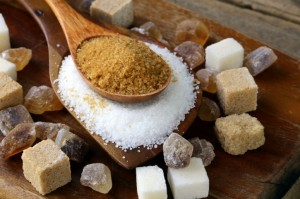
Adding up the sugar
 Now that Halloween is over, it is a good time to reevaluate how much sugar is in your (and your family’s) diet. Sugar is the downfall of weight loss surgery. It can slow down weight loss and also cause weight to be regained. Although it is true that about 80% of patients who had Gastric Bypass will experience dumping syndrome (lightheadedness and GI related symptoms after eating simple carbs), it is by no means a deterrent long term. Even patients who experience dumping syndrome will lose this negative feedback over time. The best policy is to adhere to a healthy lifestyle, regardless if you had a Lap-Band, Sleeve Gastrectomy or Gastric Bypass. A healthy lifestyle after bariatric surgery means choosing foods that are nutritionally dense, such as lean proteins, whole grains and fresh vegetables, while limiting fried foods and simple sugars such as candy, fruit juice, sugar, white pasta and white flour. Of course, daily exercise, getting enough sleep and taking time for yourself make adhering to a healthy lifestyle easier.
Now that Halloween is over, it is a good time to reevaluate how much sugar is in your (and your family’s) diet. Sugar is the downfall of weight loss surgery. It can slow down weight loss and also cause weight to be regained. Although it is true that about 80% of patients who had Gastric Bypass will experience dumping syndrome (lightheadedness and GI related symptoms after eating simple carbs), it is by no means a deterrent long term. Even patients who experience dumping syndrome will lose this negative feedback over time. The best policy is to adhere to a healthy lifestyle, regardless if you had a Lap-Band, Sleeve Gastrectomy or Gastric Bypass. A healthy lifestyle after bariatric surgery means choosing foods that are nutritionally dense, such as lean proteins, whole grains and fresh vegetables, while limiting fried foods and simple sugars such as candy, fruit juice, sugar, white pasta and white flour. Of course, daily exercise, getting enough sleep and taking time for yourself make adhering to a healthy lifestyle easier.
Naming the Sweet Stuff
It is hard to know what you are fighting if it is not always called sugar. Here are some names you need to look out for when reading food labels:
- Sugar – cane, beet, brown, invert, palm, raw
- Syrup – corn, brown rice, high fructose, maple, rice, sorghum, barley
- Juice – fruit, concentrate, dehydrated cane
- Honey and molasses
- Lactose, sucrose, saccharose, xylose
Where is the Added Sugar?
- Candy – yes, this is the obvious one. But read labels: Dark, 70% cocoa chocolate has far less sugar than the often advertised “light” candy bar Three Musketeers. We are not saying you should be munching on dark chocolate all day long, but if you need a chocolate fix, a tiny bite of high quality dark chocolate can do the trick.
- 100% fruit juice – We are very careful to avoid juice cocktails and sodas, but when it comes to juice, we do not think twice about it, right? In terms of calories, it does not matter where the sugar came from. It is easy to let the juice drinking get out of hand. A better choice would be to eat an orange instead of drinking its juice. You’ll end up with less calories and your body will be better able to digest the sugar with the added fiber of the whole fruit.
- Condiments – does your kiddo eat ketchup with his hot dog instead of the other way around? Many of us are unaware how much sugar is in ketchup, mustard, salad dressing and relish. Try making your own salad dressing and try a mango salsa with your kids’ hotdog.
- Packaged food – the rule of thumb is that if someone put it in a box, regardless if sweet or savory, it probably will have added sugar. Seems unfair. Try picking items that have few ingredients and sugar not being one of them.
- Yogurt – We all love Greek yogurt for its luscious taste and high protein content. But what, how many grams of sugar are in this? Be wise and chose unflavored yogurts that you can sweeten to your liking.
Play the Sugar Game
Would you like to really know how much you and your family are consuming in sugar? Play this game:
- 1. Grab an empty bowl and a bag of sugar
- 2. Check food labels and note how much sugar that is contained in each item that is consumed (watch the serving size for accuracy)
- 3. For each five grams of sugar, add 1 teaspoon of sugar to the bowl
- 4. See how full your bowl gets at the end of the day
Griffin Bariatrics offers many patient-centered bariatric surgery support services. To find out more about our bariatric surgery program, please sign up for a free informative seminar or contact Kim Fisher, Bariatric Care Specialist.
Get A Quick Response
Need help registering for support groups, monthly workshops or bariatric seminars? Unsure of the process or how to begin? We take pride in offering concierge style guidance for all current and potential patients.
